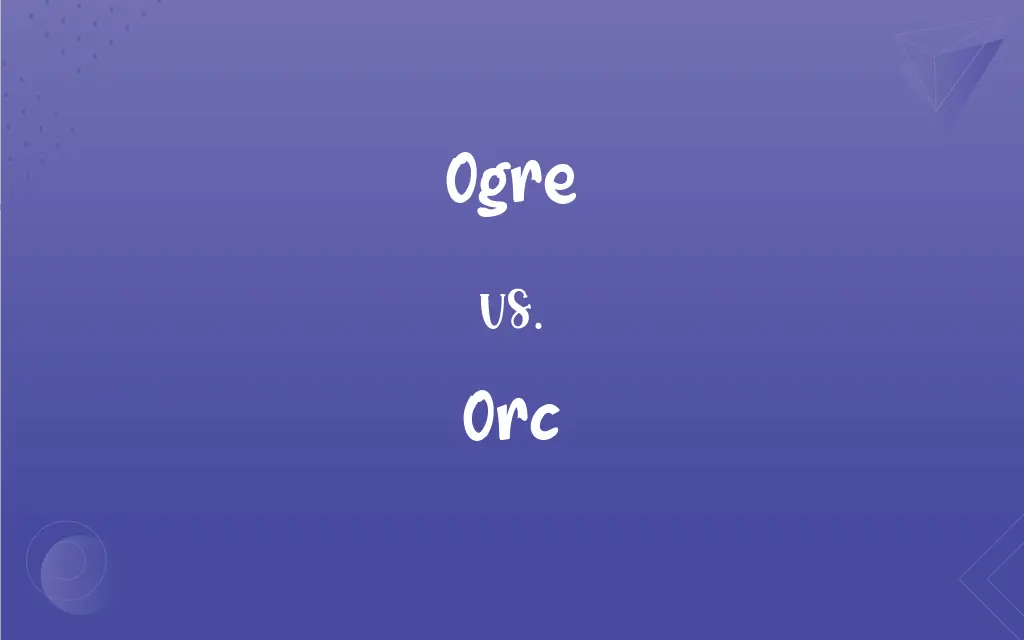Ogre vs. Orc: What's the Difference?
Edited by Harlon Moss || By Janet White || Updated on October 6, 2023
An ogre is a large, grotesque humanoid monster often found in fairy tales, while an orc is a brutish, aggressive creature common in fantasy literature and games.

Key Differences
Ogres and orcs are both creatures that have found their way into myths, legends, and pop culture. Ogres, typically depicted as large, fearsome humanoids, have their roots in folklore and fairy tales. They are often portrayed as menacing beings who might eat humans, especially children. On the other hand, orcs, popularized significantly by J.R.R. Tolkien's works, are typically seen as aggressive, war-like creatures, often pitted against elves and men. Visually, ogres often have an exaggerated, almost comical appearance, with features that can be both intimidating and grotesque. Orcs, conversely, might appear more humanoid but with greenish or grayish skin, tusks, and a generally brutish demeanor. Behaviorally, while ogres might be solitary and reside in off-beaten paths or in mountains, orcs often move in tribes or armies, showcasing their affinity for combat and war. It's important to note that while both creatures can be antagonistic, modern interpretations have provided them with depth, showcasing ogres and orcs with varying personalities, alignments, and roles in stories.
Comparison Chart
Origin
Folklore and fairy tales
Fantasy literature, notably Tolkien
Typical Depiction
Large, fearsome humanoid
Aggressive, war-like humanoid
Behavior
Often solitary, might eat humans
Often in tribes or armies, war-oriented
Physical Appearance
Grotesque, exaggerated features
Green or gray skin, tusks, brutish demeanor
ADVERTISEMENT
Modern Interpretation
Varied, can be both antagonist or protagonist
Varied, can be both villainous or misunderstood beings
Ogre and Orc Definitions
Ogre
A large and grotesque humanoid from folklore.
The children feared the ogre that lived in the mountain.
Orc
A being typically with green or gray skin and tusks.
The orc chieftain stood out with his large tusks and scars.
Ogre
A monstrous being sometimes with layers of personality.
The ogre revealed his sensitive side to those he trusted.
Orc
A creature popularized in modern times by J.R.R. Tolkien.
Tolkien's orcs were fierce enemies of the elves.
ADVERTISEMENT
Ogre
A being that is often depicted as menacing and cannibalistic.
Legends told of an ogre that preyed on wandering travelers.
Orc
A warlike humanoid creature from fantasy literature.
The orcs attacked the village at dawn.
Ogre
A term sometimes used metaphorically for a cruel or terrifying person.
The boss was an ogre when he was angry.
Orc
A member of a tribe or army in many fantasy settings.
The orc horde was feared by all neighboring kingdoms.
Ogre
A creature often associated with fairy tales.
The ogre in the story turned out to be kind-hearted.
Orc
Often depicted as brutish but can have varied personalities in modern interpretations.
The young orc sought peace, unlike his war-hungry kin.
Ogre
A giant or monster in legends and fairy tales that eats humans.
Orc
(archaic) Any of several large, ferocious sea creatures, now especially the killer whale.
Ogre
A person who is considered particularly cruel, brutish, or ugly.
Orc
A mythical evil monstrous humanoid creature, usually quite aggressive and often green.
Ogre
(mythology) A type of brutish giant from folk tales that eats human flesh.
Orc
A Russian soldier or gangster.
Ogre
(figuratively) A brutish man reminiscent of the mythical ogre.
Orc
Any of several cetaceans, especialy the grampus (Grampus griseus) of the dolphin family.
An island salt and bare,The haunt of seals, and orcs, and sea-mews' clang.
Ogre
An imaginary monster, or hideous giant of fairy tales, who lived on human beings; hence, any frightful giant; a cruel monster.
His schoolroom must have resembled an ogre's den.
Orc
A mythical monster of varying descriptions; an ogre.
Goblins, hobgoblins, and orcs of the worst description.
Ogre
A cruel wicked and inhuman person
Orc
The orca.
Ogre
(folklore) a giant who likes to eat human beings
FAQs
Do orcs have a uniform appearance?
Orcs are often seen with green or gray skin and tusks, but depictions can vary.
Are ogres known to eat humans?
Folklore often portrays ogres as beings that might eat humans, especially children.
What's the origin of ogres?
Ogres originate from folklore and fairy tales.
Is the term ogre ever used metaphorically?
Yes, "ogre" can metaphorically refer to a cruel or terrifying person.
Where did the concept of orcs gain popularity?
Orcs were notably popularized by J.R.R. Tolkien's fantasy works.
Are orcs typically solitary?
Orcs are often depicted in tribes or armies, showcasing their war-like nature.
Do orcs have any natural enemies in fantasy?
In many stories, especially Tolkien's, orcs are enemies of elves and men.
How do ogres and orcs typically differ in size?
Ogres are often depicted as larger than humans, while orcs can be of similar size to humans.
Can orcs be intelligent and organized?
Yes, many stories depict orcs with tribal structures, hierarchies, and even strategies.
Are ogres always depicted as evil?
While traditionally menacing, modern stories sometimes depict ogres with varied personalities.
How do orcs usually behave in fantasy settings?
Orcs are typically aggressive, war-oriented, and often antagonistic.
Are there any friendly ogres in pop culture?
Yes, Shrek from the "Shrek" movie series is a notable example of a friendly ogre.
Do ogres live in specific habitats?
Ogres are often depicted living in mountains, caves, or secluded areas.
Are ogres and orcs related creatures?
While both are fantastical creatures, they originate from different myths and stories.
Do all fantasy stories depict orcs as enemies?
While many do, modern interpretations can showcase orcs with diverse roles and personalities.
Are orcs ever shown as protagonists?
In modern fantasy, orcs can be protagonists, heroes, or misunderstood beings.
Can an ogre be seen as a symbol in literature?
Yes, ogres can symbolize various things, from unchecked appetite to hidden depths beneath a rough exterior.
Is the ogre's appearance consistent across cultures?
While there are common grotesque features, ogre depictions can vary based on cultural interpretations.
Can ogres possess magic or supernatural abilities?
In some tales, ogres have magical abilities or enchanted items.
Are orcs purely fictional?
Yes, orcs are fictional beings from fantasy literature and games.
About Author
Written by
Janet WhiteJanet White has been an esteemed writer and blogger for Difference Wiki. Holding a Master's degree in Science and Medical Journalism from the prestigious Boston University, she has consistently demonstrated her expertise and passion for her field. When she's not immersed in her work, Janet relishes her time exercising, delving into a good book, and cherishing moments with friends and family.
Edited by
Harlon MossHarlon is a seasoned quality moderator and accomplished content writer for Difference Wiki. An alumnus of the prestigious University of California, he earned his degree in Computer Science. Leveraging his academic background, Harlon brings a meticulous and informed perspective to his work, ensuring content accuracy and excellence.































































